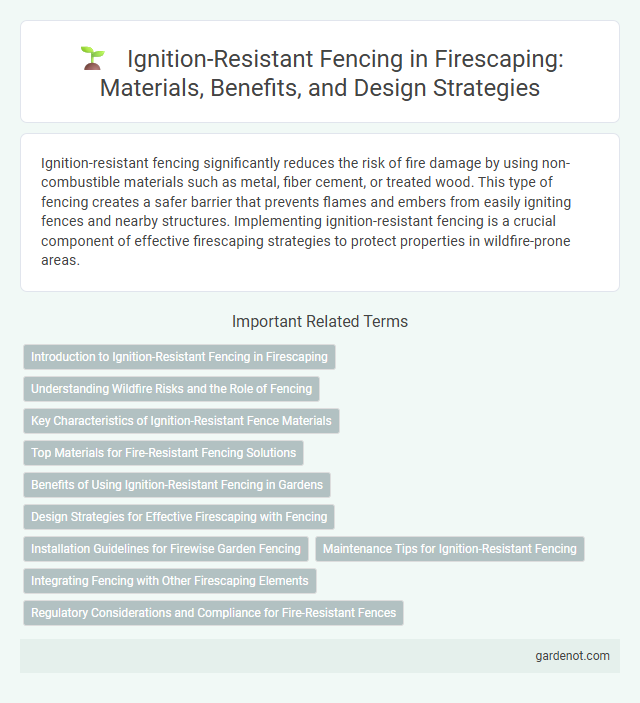Ignition-resistant fencing significantly reduces the risk of fire damage by using non-combustible materials such as metal, fiber cement, or treated wood. This type of fencing creates a safer barrier that prevents flames and embers from easily igniting fences and nearby structures. Implementing ignition-resistant fencing is a crucial component of effective firescaping strategies to protect properties in wildfire-prone areas.
Introduction to Ignition-Resistant Fencing in Firescaping
Ignition-resistant fencing plays a crucial role in firescaping by preventing the spread of wildfire embers that can ignite property boundaries. Constructed from non-combustible materials such as metal, concrete, or fiber cement, these fences enhance property protection in high-risk fire zones. Their strategic installation around homes and landscaping reduces fuel continuity and serves as a durable barrier against airborne embers.
Understanding Wildfire Risks and the Role of Fencing
Ignition-resistant fencing plays a critical role in mitigating wildfire risks by acting as a physical barrier that resists flames, embers, and heat, thereby protecting properties from direct ignition. Materials such as metal, concrete, and ignition-resistant composites are essential for constructing fences that can withstand high temperatures and reduce the spread of fire. Strategically placing ignition-resistant fencing around vulnerable areas enhances wildfire resilience by limiting fuel sources and creating defensible space.
Key Characteristics of Ignition-Resistant Fence Materials
Ignition-resistant fencing materials are specifically designed to withstand high temperatures and prevent the spread of fire, using non-combustible substances such as metal, masonry, or concrete. These fences offer enhanced durability, resist deformation under intense heat, and do not emit flammable sparks or embers. Their high thermal resistance and minimal combustible content make them essential components in effective firescaping strategies to protect properties in wildfire-prone areas.
Top Materials for Fire-Resistant Fencing Solutions
Top materials for ignition-resistant fencing include steel, wrought iron, and concrete, which provide superior fire resistance compared to wood or vinyl options. Steel fencing resists high temperatures and prevents flame penetration, while concrete barriers act as effective firebreaks, limiting spark spread. Incorporating non-combustible materials like these when designing fire-resistant fences enhances property protection during wildfires and reduces the risk of ignition near structures.
Benefits of Using Ignition-Resistant Fencing in Gardens
Ignition-resistant fencing significantly reduces the risk of fire spreading to and from garden areas by using non-combustible materials such as metal or fiber cement. This protective barrier helps safeguard plants, structures, and outdoor living spaces, enhancing overall property safety during wildfire events. Its durable construction also minimizes maintenance costs and improves the garden's resilience against embers and radiant heat exposure.
Design Strategies for Effective Firescaping with Fencing
Ignition-resistant fencing plays a crucial role in firescaping by reducing the risk of fence materials catching fire and spreading flames to adjacent structures. Utilizing non-combustible materials such as metal, fiber cement, or masonry for fencing enhances fire resistance and durability in wildfire-prone areas. Incorporating strategic placement to create defensible space and maintaining clearance from flammable vegetation ensure optimal barrier effectiveness against wildfire intrusion.
Installation Guidelines for Firewise Garden Fencing
Ignition-resistant fencing materials such as metal, fiber cement, or masonry reduce fire risk effectively in Firewise gardens. Installation guidelines emphasize maintaining a minimum 30-foot defensible space, avoiding combustible materials close to the fence, and ensuring that fencing does not trap embers or debris. Securing the fence with non-combustible fasteners and regularly clearing vegetation beneath and around the fencing enhances fire resistance and protects property from ignition sources.
Maintenance Tips for Ignition-Resistant Fencing
Regularly inspect ignition-resistant fencing made from materials like metal, concrete, or fiber cement for any signs of wear or damage that could compromise fire safety. Remove accumulated debris, leaves, and flammable vegetation near the fence line to reduce ignition risk and maintain a defensible space around the property. Ensure that any repairs use compatible, fire-resistant materials and maintain a clearance zone free from combustible materials at least 30 feet wide.
Integrating Fencing with Other Firescaping Elements
Ignition-resistant fencing enhances firescape protection by incorporating non-combustible materials like steel or aluminum, reducing fuel sources near structures. Integrating fencing with ember-resistant landscaping and defensible space practices creates a cohesive barrier against wildfire spread. Properly designed fencing works effectively alongside fire-resistant plants and hardscape zones to minimize ignition risk.
Regulatory Considerations and Compliance for Fire-Resistant Fences
Ignition-resistant fencing must comply with local fire codes such as California Fire Code (CFC) Section 504.2 and International Wildland-Urban Interface Code (IWUIC) requirements to ensure materials meet specific flame resistance and structural integrity standards. Proper documentation and regular inspections are essential to maintain compliance and reduce wildfire hazards in high-risk zones.
Ignition-resistant fencing Infographic

 gardenot.com
gardenot.com